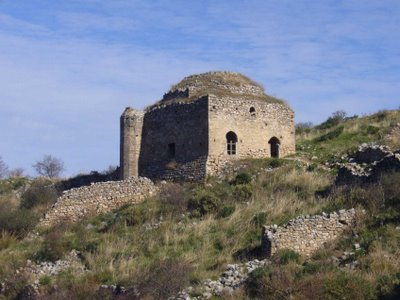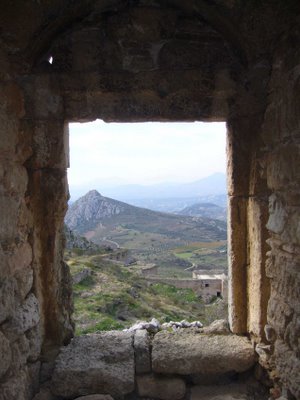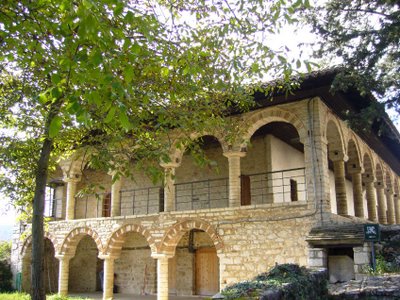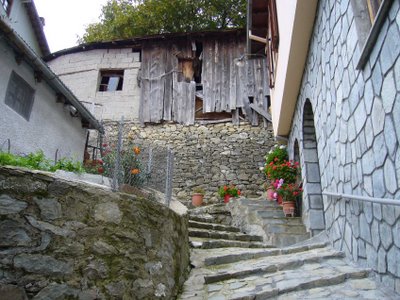I'm back from Argolida, which I absolutely loved! Since I'm stuck in bed getting my strength back after a stomach flu (along with 11 out of the 24 who went on the trip... so far...) that we affectionately have taken to calling "the plague", I have time finally to add a few photos to the blog. Maybe I'll even have time to go back and fill in all the blanks from my previous trips! One way or another, I'm not setting foot in the library before Monday.
Many thanks to my Giannis for writing the program for the photo compression. Also for being my Giannis. :-)
 The beach below the citadel of Asine. This beach looks absolutely beautiful in November. Something tells me though that it is quite popular in the summer, and maybe even be identified with Tolo. I hope not. I was at the archaeological site, not the beach, so I'm not too clear on the details.
The beach below the citadel of Asine. This beach looks absolutely beautiful in November. Something tells me though that it is quite popular in the summer, and maybe even be identified with Tolo. I hope not. I was at the archaeological site, not the beach, so I'm not too clear on the details.
 Here we're looking down from the Asine citadel onto the other side, at another little beach. It's not hard to understand why I really liked it at this site.
Here we're looking down from the Asine citadel onto the other side, at another little beach. It's not hard to understand why I really liked it at this site.
 Here we have some Hellenistic walling at Asine.
Here we have some Hellenistic walling at Asine.
 The citadel of Mycenae. How to get this photo angle is a secret that I am not telling! However, it did involve a leisurely walk that measured exactly 10 km by my pedometer. This walk wins the "best thing we did on this trip" award by a landslide.
The citadel of Mycenae. How to get this photo angle is a secret that I am not telling! However, it did involve a leisurely walk that measured exactly 10 km by my pedometer. This walk wins the "best thing we did on this trip" award by a landslide.
 This is the beautiful Argive plain, stretching away toward the sea and Nafplio, as seen from the citadel of Midea (seeing a trend here?). Some weird story has Medea's golden chariot buried up there somewhere. I'm not too clear on the connection between Midea and Medea. Predicatably, the chariot has not been found, not for lack of trying.
This is the beautiful Argive plain, stretching away toward the sea and Nafplio, as seen from the citadel of Midea (seeing a trend here?). Some weird story has Medea's golden chariot buried up there somewhere. I'm not too clear on the connection between Midea and Medea. Predicatably, the chariot has not been found, not for lack of trying.

Midea was built onto the side of a steep hill. This view looks down from the top of the hill onto the Megaron. The most memorable of the finds was the skeleton of a woman who was crushed when a huge boulder fell off the fortification wall and crushed her to death, probably the result of an earthquake. This is a very seismically active area.

This is the citadel of Tiryns. The weird thing about it is the round building in the middle which might be a silo for grain. Or maybe a temple, or a palace, or some other thing that no one has written an article about yet. They didn't find any grain in it, anyway. Also, it was a Mycenaean palace.  This is a street sign for the Tiryns dam. I messed up the resolution when I cropped it but if you could zoom in you'd see that it says, under the Linear B, "Greek script of 1700 BC", which is just plain wrong. If my Linear B skills were better, I'd also be able to explain why their translation of "Mycenaean Dam" is wrong too, but just trust me, it is. (They spelled "Mycenaean" wrong too, but that's not surprising.)
This is a street sign for the Tiryns dam. I messed up the resolution when I cropped it but if you could zoom in you'd see that it says, under the Linear B, "Greek script of 1700 BC", which is just plain wrong. If my Linear B skills were better, I'd also be able to explain why their translation of "Mycenaean Dam" is wrong too, but just trust me, it is. (They spelled "Mycenaean" wrong too, but that's not surprising.)
 This is the citadel of -- no, wait, this is the church of Merbaka. Merbaka is not Greek, it's Belgian or something (Merboeke). And the Church has a lot of western influence, so if you were thinking it looks like another Greek Orthodox Church, um, well, I don't know. That's what Guy says.
This is the citadel of -- no, wait, this is the church of Merbaka. Merbaka is not Greek, it's Belgian or something (Merboeke). And the Church has a lot of western influence, so if you were thinking it looks like another Greek Orthodox Church, um, well, I don't know. That's what Guy says.
 The Argive Heraion. Winner of the "why the heck didn't we go there with the Summer Session??" award. It's a complex of buildings that are associated with worshipping the goddess Hera, who was a big deal in this part of the world at one time.
The Argive Heraion. Winner of the "why the heck didn't we go there with the Summer Session??" award. It's a complex of buildings that are associated with worshipping the goddess Hera, who was a big deal in this part of the world at one time.

This is the Great Theater at Argos. I did my presentation on this, as well as several other theaters at Argos. This was a great theater, with lovely dramatic and musical performances, until the Romans screwed with it and turned it into an arena for gladiator games and what the French who excavated it call "water ballets," and I roughly translate "synchronized swimming."

I liked this spot very much. It had shade, sunlight, and an archaeological site overflowing with Mycenaean pottery. All around the best picnic spot that we didn't actually picnic at, ever.
 The main function of the pyramid at Elliniko seems to be to giggle at Martin Bernal for trying to use it as evidence of Egyptian origins of Greek culture. Also it's fun to climb on. Note more examples of beautiful Hellenistic walling.
The main function of the pyramid at Elliniko seems to be to giggle at Martin Bernal for trying to use it as evidence of Egyptian origins of Greek culture. Also it's fun to climb on. Note more examples of beautiful Hellenistic walling.

The view from the pyramid over the beautiful Argive plain. In case you were doubting your knowledge of Greek history, the Hellenistic period dates to at least a thousand years after the end of Egyptian cultural dominance in the Mediterranean. Sorry Bernal.

If you start walking uphill from the theater at Argos and keep going for a few hours, you will get to the castle of Larissa, which overlooks the whole of Argos and the ... Argive plain again. It's worth the climb all the way to the top, especially by bus.
If you have ever drunk Nemean wine, chances are it came from this valley.
This is the temple of Zeus at Nemea, where they got drunk on good Nemean wine and watched the Nemean games and, when you won, they gave you a wreath of celery to wear on your head because this one time, there was a baby who was fated to die if he touched the ground before he could walk, and his nurse put him on a bed of celery in order to give some water to some other guys, and he was bitten by a snake and died, and in his honor the other guys started the games. It was really cold and wet that day.

This photo wins the award of being the "first photo I've ever taken while sitting on a toilet." This is from the Nemea Archaeological Museum, a wonderful place built and run by Americans. This is the only place I have ever seen this kind of sign in all of Greece.

This photo was shot from the creepy site of Stymphalis. This is the Stymphalian Lake. Stymphalis is of interest to me because of the weird theater-like rock-carved structure that it has, which makes me very curious. I will have to look into it and find out what the excavators have to say on the subject. Other than that, I should point out that Stymphalis does not have a Mediterranean climate, and therefore is good only for growing potatoes, garlic, and apples.
 Is this a picture of a Classics professor A) herding sheep; B) having a meeting with another Classics professor; or C) all of the above? Very good, the correct answer is C.
Is this a picture of a Classics professor A) herding sheep; B) having a meeting with another Classics professor; or C) all of the above? Very good, the correct answer is C. 
Dendra has some really amazing chamber tombs, and a weird horse burial, but it also has some incredibly nice people and beautiful November flowers. If you ever went to the Nafplio Archaeological Museum before they closed it, all their really good stuff came out of these chamber tombs.
 The temple of Apollo at Corinth when we were done for the day.
The temple of Apollo at Corinth when we were done for the day.
 The ruined Fetiyeh mosque inside the walls of Acrocorinth.
The ruined Fetiyeh mosque inside the walls of Acrocorinth. Standing inside the mosque looking out over Acrocorinth and the surrounding hills.
Standing inside the mosque looking out over Acrocorinth and the surrounding hills. The fortifications (mostly Medieval) of Acrocorinth.
The fortifications (mostly Medieval) of Acrocorinth. More Acrocorinth fortifications.
More Acrocorinth fortifications.




 The courtyard of the Sikyon museum.
The courtyard of the Sikyon museum.

 The beach below the citadel of Asine. This beach looks absolutely beautiful in November. Something tells me though that it is quite popular in the summer, and maybe even be identified with Tolo. I hope not. I was at the archaeological site, not the beach, so I'm not too clear on the details.
The beach below the citadel of Asine. This beach looks absolutely beautiful in November. Something tells me though that it is quite popular in the summer, and maybe even be identified with Tolo. I hope not. I was at the archaeological site, not the beach, so I'm not too clear on the details. Here we're looking down from the Asine citadel onto the other side, at another little beach. It's not hard to understand why I really liked it at this site.
Here we're looking down from the Asine citadel onto the other side, at another little beach. It's not hard to understand why I really liked it at this site. Here we have some Hellenistic walling at Asine.
Here we have some Hellenistic walling at Asine.  The citadel of Mycenae. How to get this photo angle is a secret that I am not telling! However, it did involve a leisurely walk that measured exactly 10 km by my pedometer. This walk wins the "best thing we did on this trip" award by a landslide.
The citadel of Mycenae. How to get this photo angle is a secret that I am not telling! However, it did involve a leisurely walk that measured exactly 10 km by my pedometer. This walk wins the "best thing we did on this trip" award by a landslide. 


 This is a street sign for the Tiryns dam. I messed up the resolution when I cropped it but if you could zoom in you'd see that it says, under the Linear B, "Greek script of 1700 BC", which is just plain wrong. If my Linear B skills were better, I'd also be able to explain why their translation of "Mycenaean Dam" is wrong too, but just trust me, it is. (They spelled "Mycenaean" wrong too, but that's not surprising.)
This is a street sign for the Tiryns dam. I messed up the resolution when I cropped it but if you could zoom in you'd see that it says, under the Linear B, "Greek script of 1700 BC", which is just plain wrong. If my Linear B skills were better, I'd also be able to explain why their translation of "Mycenaean Dam" is wrong too, but just trust me, it is. (They spelled "Mycenaean" wrong too, but that's not surprising.) 


 I liked this spot very much. It had shade, sunlight, and an archaeological site overflowing with Mycenaean pottery. All around the best picnic spot that we didn't actually picnic at, ever.
I liked this spot very much. It had shade, sunlight, and an archaeological site overflowing with Mycenaean pottery. All around the best picnic spot that we didn't actually picnic at, ever. The main function of the pyramid at Elliniko seems to be to giggle at Martin Bernal for trying to use it as evidence of Egyptian origins of Greek culture. Also it's fun to climb on. Note more examples of beautiful Hellenistic walling.
The main function of the pyramid at Elliniko seems to be to giggle at Martin Bernal for trying to use it as evidence of Egyptian origins of Greek culture. Also it's fun to climb on. Note more examples of beautiful Hellenistic walling.





 Is this a picture of a Classics professor A) herding sheep; B) having a meeting with another Classics professor; or C) all of the above? Very good, the correct answer is C.
Is this a picture of a Classics professor A) herding sheep; B) having a meeting with another Classics professor; or C) all of the above? Very good, the correct answer is C. 







 More Ioannina.
More Ioannina.
















 More Metsovo.
More Metsovo.
 Metsovo and the Pindos Mtns. in the background.
Metsovo and the Pindos Mtns. in the background.
